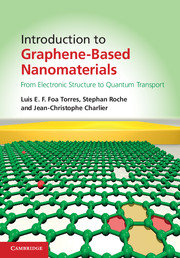Book contents
- Frontmatter
- Contents
- Preface
- 1 Introduction to carbon-based nanostructures
- 2 Electronic properties of carbon-based nanostructures
- 3 Quantum transport: general concepts
- 4 Klein tunneling and ballistic transport in graphene and related materials
- 5 Quantum transport in disordered graphene-based materials
- 6 Quantum transport beyond DC
- 7 Ab initio and multiscale quantum transport in graphene-based materials
- 8 Applications
- Appendix A Electronic structure calculations: the density functional theory (DFT)
- Appendix B Electronic structure calculations: the many-body perturbation theory (MBPT)
- Appendix C Green's functions and ab initio quantum transport in the Landauer–Büttiker formalism
- Appendix D Recursion methods for computing the DOS and wavepacket dynamics
- References
- Index
1 - Introduction to carbon-based nanostructures
Published online by Cambridge University Press: 05 February 2014
- Frontmatter
- Contents
- Preface
- 1 Introduction to carbon-based nanostructures
- 2 Electronic properties of carbon-based nanostructures
- 3 Quantum transport: general concepts
- 4 Klein tunneling and ballistic transport in graphene and related materials
- 5 Quantum transport in disordered graphene-based materials
- 6 Quantum transport beyond DC
- 7 Ab initio and multiscale quantum transport in graphene-based materials
- 8 Applications
- Appendix A Electronic structure calculations: the density functional theory (DFT)
- Appendix B Electronic structure calculations: the many-body perturbation theory (MBPT)
- Appendix C Green's functions and ab initio quantum transport in the Landauer–Büttiker formalism
- Appendix D Recursion methods for computing the DOS and wavepacket dynamics
- References
- Index
Summary
Carbon is a truly unique chemical element. It can form a broad variety of architectures in all dimensions, both at the macroscopic and nanoscopic scales. During the last 20+ years, brave new forms of carbon have been unveiled. The family of carbon-based materials now extends from C60 to carbon nanotubes, and from old diamond and graphite to graphene. The properties of the new members of this carbon family are so impressive that they may even redefine our era. This chapter provides a brief overview of these carbon structures.
Carbon structures and hybridizations
Carbon is one of the most versatile elements in the periodic table in terms of the number of compounds it may create, mainly due to the types of bonds it may form (single, double, and triple bonds) and the number of different atoms it can join in bonding. When we look at its ground state (lowest energy) electronic configuration, 1s22s22p2, carbon is found to possess two core electrons (1s) that are not available for chemical bonding and four valence electrons (2s and 2p) that can participate in bond formation (Fig. 1.1(a)). Since two unpaired 2p electrons are present, carbon should normally form only two bonds from its ground state.
However, carbon should maximize the number of bonds formed, since chemical bond formation will induce a decrease of the system energy. Consequently, carbon will re-arrange the configuration of these valence electrons.
- Type
- Chapter
- Information
- Introduction to Graphene-Based NanomaterialsFrom Electronic Structure to Quantum Transport, pp. 1 - 10Publisher: Cambridge University PressPrint publication year: 2014



